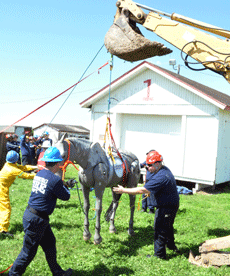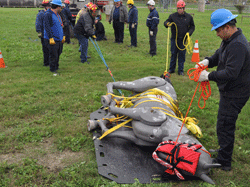Large Animal Rescue course focuses on safety of responder and victim


The course teaches the unified incident command system (ICS) as well as the basic concepts required for safe and effective technical rescue of injured or entrapped livestock. Among the topics covered are handling and restraint, leading and loading, as well as the use of rope systems, slings and vertical lift systems. The course is designed for veterinary personnel, firefighters and EMS, first responders, law enforcement and animal control personnel.
Twenty-four people from nine organizations involved in animal health and emergency response recently attended the Large Animal Rescue Expanded Operations: Integrating Veterinary Medicine & First Responders in Edinburg, TX. Instructors were Dallas Renfrew, Darren Smith and David Rosier of TEEX, along with C.J. Mabry and Cheryl Ellis of the Texas A&M Vet School.
Attendees participated in multiple scenarios that simulated large animals trapped in a variety of situations. Class participants rescued the animal (a “horse-akin” named Star) using techniques they had learned during the class.
Due to a large animal’s size and difficulties in communicating and dealing with its fight or flight instincts, performing a rescue presents an increased risk of injury for the responder.


To prepare for these kinds of incidents, it is important for communities to train an animal disaster response team to ensure that animal disasters do not escalate and endanger the public, Renfrew added. “Individuals who have been trained to work safely around animals in emergency situations and who have the technical capabilities to perform complicated rescue procedures are less likely to sustain injuries themselves, and more likely to perform a successful rescue.”
“The Texas A&M College of Veterinary Medicine & Biomedical Sciences and the Texas A&M Veterinary Emergency Team is excited to partner with TEEX in the animal rescue arena,” said Assistant Professor Dr. Wesley Bissett, DVM, PhD, who serves as Director of the Veterinary Emergency Team. “The training will result in partnerships between the veterinary medical and first-responder communities and result in more effective and efficient rescue efforts on animals’ behalf. The end result is that combining these disciplines will save lives.”
For more information, contact: [email protected]
Media Contacts:
Brian Blake, Communications Director
[email protected]
PH: 979-458-6837, Cell: 979-324-8995
Will Welch
[email protected]
PH: 979-458-6979, Cell: 979-220-2840
